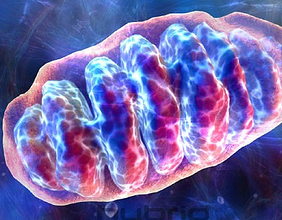Difference Between Aerobic and Anaerobic Cellular Respiration
 Cellular respiration is a series of the metabolic reactions occurs in cells in order to convert nutrients into a small energy molecule called adenosine triphosphate (ATP).
Cellular respiration is a series of the metabolic reactions occurs in cells in order to convert nutrients into a small energy molecule called adenosine triphosphate (ATP).
Aerobic respiration requires oxygen in order to generate energy molecule ATP, where as an anaerobic respiration synthesize ATP by using the electron transport chain, with inorganic molecules other than oxygen.
Anaerobic Respiration is typically referred to as fermentation and no oxygen is used in the process. There are two types of fermentation which include lactic acid fermentation or alcoholic fermentation.
The lactic acid fermentation sometimes occurs in muscle cells when there is a lack of oxygen supply to the muscle cells. You may feel the burning sensation while you exercise and this is due to the production of lactic acid.
Cells obtain the energy stored in food by breaking the sugar molecules apart by enzyme-mediated reactions. Energy is obtained more efficiently in the presence of oxygen via the process called aerobic respiration. When there is no oxygen available to break the sugar molecules, some cells are still able to produce energy by the process called fermentation or anaerobic cellular respiration or anaerobic glycolysis.
Certain organisms do not need molecular oxygen to produce the energy molecules called ATP. These organisms utilize ATP by the metabolic pathway which involves the sequential conversion of carbohydrates into partially oxidized end product(s).
For instance, the free-living (non-parasitic) unicellular fungus such as Brewer’s yeast (Saccharomyces cereviseae) is able to ferment various disaccharides and monosaccharides. In the process of Yeast fermentation or anaerobic respiration, the most sugars are broken to yield ethanol and carbon dioxide.
Aerobic respiration on the other hand, almost all eukaryotic and many prokaryotic organisms are solely dependent upon a continuous supply of oxygen molecules to sustain life. It is a catabolic reaction which theoretical yield of 36-38 ATP molecules per glucose during cellular respiration.
In aerobic respiration oxygen is taken into the organism and being used as the terminal electron acceptor in the electron transport chain. It appears as part of a water molecule at the end of the aerobic reaction.
In the Krebs cycle, carbon dioxide is removed by decarboxylation reactions and hydrogen atoms are removed from the intermediates and transferred to oxygen. Finally, the carbon dioxide generated in mitochondria is released as a waste product to the environment.
Therefore, carbohydrates breaks into sugar then into ATP. The overall process of aerobic respiration will be shown by the following reaction.
C6H12O6 + 6O2 + 6H2O ——> 6CO2 + 12H2O + energy
- Difference Between CA and CMA - February 1, 2010
- Difference Between CGA and CMA - January 30, 2010
- Difference Between Molds and Yeast - January 27, 2010
Search DifferenceBetween.net :
 Email This Post
: If you like this article or our site. Please spread the word. Share it with your friends/family.
Email This Post
: If you like this article or our site. Please spread the word. Share it with your friends/family.

